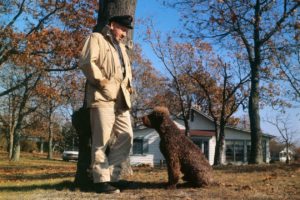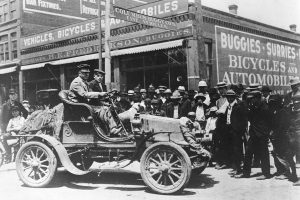From prehistoric times to the age of Covid-19, people have looked to animals for companionship.
May 7, 2020
Americans have been adopting pets at a record pace since the pandemic began. It’s as if the crisis has intensified our need for animal companionship, which goes back a long way. Scientists agree that dogs were the first species to form a relationship with humans: Inside Chauvet Cave, a Paleolithic site in southern France, archaeologists recently found 26,000-year-old canine paw prints alongside those of a human child.

John Steinbeck with his dog Charley.
PHOTO: BETTMANN ARCHIVE/GETTY IMAGES
Humans kept animals as companions long before we domesticated livestock like sheep, goats and cattle, some 10,000 years ago. By contrast, horses were only tamed in Eurasia around 6,000 years ago. Though they weren’t household pets, they inspired passionate feelings in their owners, as the equine imagery of ancient art and poetry so beautifully attests.
One of the first pet dogs whose name is known to us is Abutiu, who belonged to an Egyptian pharaoh in the early third millennium B.C. After Abutiu’s death, his heartbroken owner gave him a royal burial. The inscription on the tomb explained, ‘His Majesty did this for him in order that he might be honored before the great god, Anubis.’
By around 1000 B.C., the Egyptians’ love affair with dogs had given way to an obsession with cats, which they revered as semi-divine creatures. It was illegal to kill a cat or take one out of Egypt. The ancient Greeks were baffled by Egyptian felinophilia; they were more taken by the loyalty of canines. In Homer’s Odyssey, the old dog Argos waits 20 years for Odysseus to return, then dies content once he has seen his master.
The Romans made pets of cats, dogs, snakes, insects and birds—indeed, almost anything that breathed, except for goldfish. Those didn’t become household companions until 1369, when China’s Hongwu Emperor ordered the creation of the first fishbowl.
Pet ownership was a status symbol in early modern Europe, like having a carriage. Cardinal Richelieu, an adviser to the French King Louis XIII, shared his rooms with 12 cats, while Madame du Barry, the mistress of Louis XV, kept an orangutan and a parrot. Almost no one bothered to house-train their pets, much to the chagrin of unwary visitors to Versailles.
During the French Revolution, pedigree pets suffered by association with their aristocratic owners. The future Empress Josephine was incarcerated in Paris along with her pet pug Fortuné. Always protective of its mistress, the dog reacted badly on her wedding night to Napoleon in 1796, sinking its teeth into his leg.
As the cult of Romanticism swept through Europe in the 19th century, a pet became more than just a companion. It was an alter ego and “loving friend,” as Elizabeth Barrett Browning wrote in her poem “To Flush, My Dog.” Many authors felt the same way about their pets: Charles Dickens had his pet raven Grip, Ernest Hemingway had his six-toed cat Uncle Willie, and of course John Steinbeck had his poodle Charley, whom he immortalized in his 1962 book “Travels with Charley.”
They aren’t alone; a 2018 meta-review of mental health studies by researchers at Liverpool University confirmed the emotional benefits of pet ownership. Steinbeck once admitted to his publisher: “I need a dog pretty badly. I dreamed of dogs last night. They sat in a circle and looked at me and I wanted all of them.”







